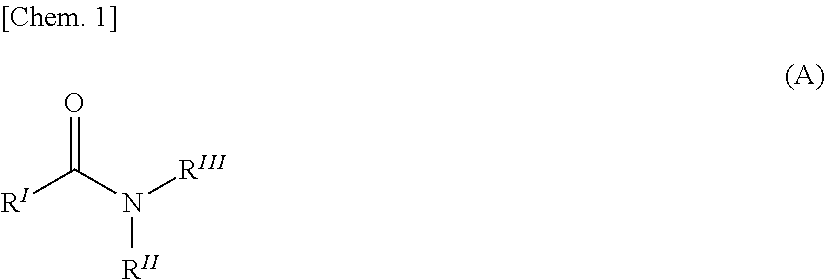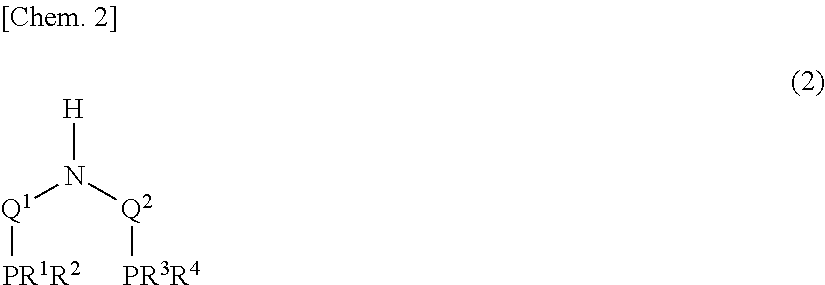Method for producing alcohol and/or amine from amide compound
a technology of amide compound and amide compound, which is applied in the preparation of amino compound, organic compound/hydride/coordination complex catalyst, physical/chemical process catalyst, etc., can solve the problem of unstable ruthenium phosphine complex used as catalyst, and achieve the effect of easy preparation, easy preparation, and easy preparation
- Summary
- Abstract
- Description
- Claims
- Application Information
AI Technical Summary
Benefits of technology
Problems solved by technology
Method used
Image
Examples
example 1
[0129]A ruthenium carbonyl complex 1 was produced according to the following equation.
[0130]
[0131]Under the stream of nitrogen, 4.18 mmol of amine hydrochloride shown in the above equation was placed in a 100 mL-flask and suspended in 33 mL of toluene, and 14 mL of 15% aqueous NaOH solution was added thereto and the resulting mixture was stirred at room temperature until no solid remained. The resulting solution was separated into an organic phase and an aqueous phase, and the organic phase was washed with 14 mL of distilled water (2 times) and the aqueous phase was subjected to extraction with 14 mL of toluene (2 times). The thus obtained organic phases were mixed and dried with sodium sulfate, and then the solvent was distilled away to obtain a free amine.
[0132]4.18 mmol of the ruthenium carbonyl complex shown in the above equation was placed in a 200 mL-flask, and the flask was purged with nitrogen. Then, the free amine dissolved in 33 mL of toluene was added to the flask, and th...
example 2
[0134]1-octanol was produced from N,N-dimethyloctanamide according to the following equation
[0135]
[0136]0.01 mmol of the complex 1 produced in Example 1 was placed in a 50 mL-autoclave equipped with a stirrer, and the autoclave was purged with nitrogen. 300 microliters of methanol, 1 mmol of N,N-dimethyloctanamide, and 500 microliters of methanol solution of 2.0 M sodium methoxide were added to the autoclave, and the autoclave was purged with hydrogen. The resulting mixture was stirred under hydrogen atmosphere (5 MPa) and 100 degrees C. for 16 hours to obtain a reaction solution. The reaction solution was analyzed by gas chromatography, and as a result, it was confirmed that the GC area percentage of the amide as a raw material was 2% and the GC area percentage of 1-octanol was 92%.
examples 3 to 8
[0137]An alcohol was produced in the same manner as in Example 2 except that the type of raw material used and the amount of the catalyst were changed. The results of Examples 2 to 8 are shown in Table 1.
[0138]
TABLE 1MaterialAlcoholSampleCatalyst(GC(GCNo.Substrate(mol %)area %)area %)212923168254167335109660 .1010071989814555
PUM
| Property | Measurement | Unit |
|---|---|---|
| RI | aaaaa | aaaaa |
| pressure | aaaaa | aaaaa |
| pressure | aaaaa | aaaaa |
Abstract
Description
Claims
Application Information
 Login to View More
Login to View More - R&D
- Intellectual Property
- Life Sciences
- Materials
- Tech Scout
- Unparalleled Data Quality
- Higher Quality Content
- 60% Fewer Hallucinations
Browse by: Latest US Patents, China's latest patents, Technical Efficacy Thesaurus, Application Domain, Technology Topic, Popular Technical Reports.
© 2025 PatSnap. All rights reserved.Legal|Privacy policy|Modern Slavery Act Transparency Statement|Sitemap|About US| Contact US: help@patsnap.com



